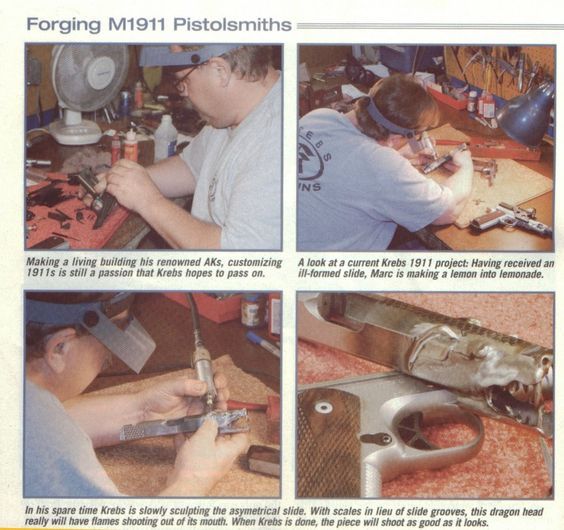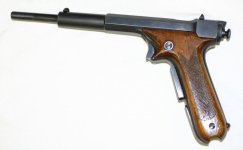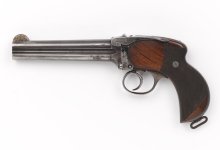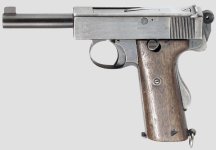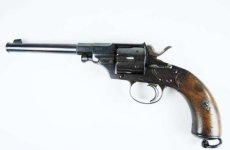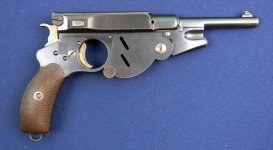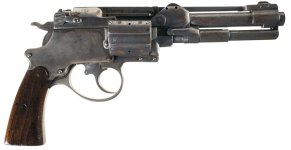You are using an out of date browser. It may not display this or other websites correctly.
You should upgrade or use an alternative browser.
You should upgrade or use an alternative browser.
What the heck
- Thread starter Ozzieman
- Start date
20 minutes,,, not a record but good one mikejonestkd
680 Savage Model 1907
https://en.wikipedia.org/wiki/Savage_Model_1907
The Savage Model 1907 is a semi-automatic pocket pistol produced by the Savage Arms Company of Utica, New York, from 1907 until 1920 in .32 ACP and from 1913 until 1920 in .380 ACP caliber. Although smaller in size, it is derived from the .45 semi-automatic pistol Savage submitted to the 1906-1911 US Army trials to choose a new semi-automatic sidearm. After several years of testing the Savage pistol was one of two finalists but ultimately lost to the Colt entry, which became famous as the Colt Model 1911. 181 of these .45 ACP pistols were returned to Savage after the testing and sold on the civilian market.[1]
Name and marketing[edit]
The Model 1907 is often erroneously called a Model 1905 because of the date Nov. 21, 1905 date stamped into the top of the slide on all Savage semi-automatic pistols. This is the date Elbert Searle was awarded one of his firearm patents, which were the design basis for all the Savage semi-automatic pistols.
Advertised with the slogan "Ten shots quick!", the Model 1907 was very popular because, despite its small size, it had a 10 round double-stack magazine. The advertising included a number of early celebrity endorsers, including William "Buffalo Bill" Cody, Bat Masterson, and the Pinkerton Agency. Teddy Roosevelt was even presented with a Model 1907. Much of the advertising in the popular press played on the ability of an otherwise defenseless woman to use the Savage to subdue burglars and "tramps."
Design[edit]
A safety lever is located on the left side of the pistol, at the upper rear of the grip. Though it appears to have an external hammer, it is actually a striker-fired gun; the "hammer" is actually a cocking lever. Model 1907s made from 1913 until 1917 had a collared barrel and a loaded chamber indicator, allowing the shooter to tell by touching the shell ejection port whether a cartridge was chambered. The Model 1907 uses no screws (even the grips snap into place) and is simple to strip. The grips were made from gutta-percha, though some early production examples had metal grips. In 1912 the Model 1907 underwent a major design revision modifying almost every major component.
As with most semi-automatics, the pistol is readied for firing by pulling back and releasing the slide, which inserts a cartridge into the chamber and cocks the pistol. The recoil from firing a cartridge automatically extracts and ejects the empty shell, cocks the firing pin and loads another cartridge into the chamber, ready for firing.
Variants[edit]
Savage made two other very similar semi-automatic pistols, with many parts in common with the Model 1907. The first was the hammerless Model 1915; the .32 Model 1915 was made only in 1915 and 1916 and the .380 model from 1915 until 1917. Like the Model 1907, the Model 1915 uses no screws. The other is the Model 1917, made from 1920 until 1926 in .32 and from 1920 until 1928 in .380. The Model 1917 is mechanically the same as and shares almost all of its parts with the final version of the Model 1907 (including a smaller, thinner cocking lever "hammer"), but with a significantly larger handle. Because this required larger grips, the Model 1917 uses one screw through each grip to hold them to the pistol frame.
Military use[edit]
Although the Model 1907 was designed for civilian use, the French government purchased over 40,000 .32 ACP Model 1907s between late 1914 and 1917 for the French military in World War I. These military "contract" pistols are recognized by the presence of a loaded chamber indicator and a lanyard ring, or mounting holes in the grip for a lanyard ring; lanyard rings were not available on civilian pistols. The Savage Model 1907 pictured to the right is a French contract pistol. A much smaller contract of 1,150 pistols in the same configuration were purchased by Portugal, which are distinguished by grips bearing the lesser arms of Portugal instead of the standard Indian head.
In popular culture[edit]
In the 1978 film noir parody The Cheap Detective, Sid Caesar's character, Ezra Desire, uses a model 1907,[2] as does Jude Law's character Harlan Maquire in the 2002 crime drama Road to Perdition.[3]
680 Savage Model 1907
https://en.wikipedia.org/wiki/Savage_Model_1907
The Savage Model 1907 is a semi-automatic pocket pistol produced by the Savage Arms Company of Utica, New York, from 1907 until 1920 in .32 ACP and from 1913 until 1920 in .380 ACP caliber. Although smaller in size, it is derived from the .45 semi-automatic pistol Savage submitted to the 1906-1911 US Army trials to choose a new semi-automatic sidearm. After several years of testing the Savage pistol was one of two finalists but ultimately lost to the Colt entry, which became famous as the Colt Model 1911. 181 of these .45 ACP pistols were returned to Savage after the testing and sold on the civilian market.[1]
Name and marketing[edit]
The Model 1907 is often erroneously called a Model 1905 because of the date Nov. 21, 1905 date stamped into the top of the slide on all Savage semi-automatic pistols. This is the date Elbert Searle was awarded one of his firearm patents, which were the design basis for all the Savage semi-automatic pistols.
Advertised with the slogan "Ten shots quick!", the Model 1907 was very popular because, despite its small size, it had a 10 round double-stack magazine. The advertising included a number of early celebrity endorsers, including William "Buffalo Bill" Cody, Bat Masterson, and the Pinkerton Agency. Teddy Roosevelt was even presented with a Model 1907. Much of the advertising in the popular press played on the ability of an otherwise defenseless woman to use the Savage to subdue burglars and "tramps."
Design[edit]
A safety lever is located on the left side of the pistol, at the upper rear of the grip. Though it appears to have an external hammer, it is actually a striker-fired gun; the "hammer" is actually a cocking lever. Model 1907s made from 1913 until 1917 had a collared barrel and a loaded chamber indicator, allowing the shooter to tell by touching the shell ejection port whether a cartridge was chambered. The Model 1907 uses no screws (even the grips snap into place) and is simple to strip. The grips were made from gutta-percha, though some early production examples had metal grips. In 1912 the Model 1907 underwent a major design revision modifying almost every major component.
As with most semi-automatics, the pistol is readied for firing by pulling back and releasing the slide, which inserts a cartridge into the chamber and cocks the pistol. The recoil from firing a cartridge automatically extracts and ejects the empty shell, cocks the firing pin and loads another cartridge into the chamber, ready for firing.
Variants[edit]
Savage made two other very similar semi-automatic pistols, with many parts in common with the Model 1907. The first was the hammerless Model 1915; the .32 Model 1915 was made only in 1915 and 1916 and the .380 model from 1915 until 1917. Like the Model 1907, the Model 1915 uses no screws. The other is the Model 1917, made from 1920 until 1926 in .32 and from 1920 until 1928 in .380. The Model 1917 is mechanically the same as and shares almost all of its parts with the final version of the Model 1907 (including a smaller, thinner cocking lever "hammer"), but with a significantly larger handle. Because this required larger grips, the Model 1917 uses one screw through each grip to hold them to the pistol frame.
Military use[edit]
Although the Model 1907 was designed for civilian use, the French government purchased over 40,000 .32 ACP Model 1907s between late 1914 and 1917 for the French military in World War I. These military "contract" pistols are recognized by the presence of a loaded chamber indicator and a lanyard ring, or mounting holes in the grip for a lanyard ring; lanyard rings were not available on civilian pistols. The Savage Model 1907 pictured to the right is a French contract pistol. A much smaller contract of 1,150 pistols in the same configuration were purchased by Portugal, which are distinguished by grips bearing the lesser arms of Portugal instead of the standard Indian head.
In popular culture[edit]
In the 1978 film noir parody The Cheap Detective, Sid Caesar's character, Ezra Desire, uses a model 1907,[2] as does Jude Law's character Harlan Maquire in the 2002 crime drama Road to Perdition.[3]
dakota.potts
New member
I thought that looked like a Schwarzlose design, but some digging shows that to most likely be a Hino Komuro 1908.
Sorry about taking so long getting back on this one but work has taken me out of the country several times in the last couple of weeks
Good one dakota.potts
681 Hino-Komuro 1908
http://www.forgottenweapons.com/early-automatic-pistols/hino-komuro-1908/
https://en.wikipedia.org/wiki/Hino–Komuro_pistol
The Hino–Komuro M1908 was a blow-forward operated, semi-automatic pistol of Japanese origin and was patented by Yujiro Komuro.
It was chambered in 8mm Nambu, .32 ACP, and .25 ACP. The 8mm chambering was later dropped as the cartridge proved too powerful for the design.
As of December 1992, a cache of 17 Hino–Komuro Pistols chambered in .32 ACP were found in a warehouse that are believed to have been stored for 45 years and seven were retained by Japanese authorities for evaluation when the rest were scheduled for destruction as they were not legally registered. A small number of these weapons are considered highly collectible firearms in the United States.
The designer himself, Kumazo Hino, was also famous as a great inventor and an aviation pioneer. Most of the records were lost when Hino's home in Tokyo was fire bombed during World War II.
Good one dakota.potts
681 Hino-Komuro 1908
http://www.forgottenweapons.com/early-automatic-pistols/hino-komuro-1908/
https://en.wikipedia.org/wiki/Hino–Komuro_pistol
The Hino–Komuro M1908 was a blow-forward operated, semi-automatic pistol of Japanese origin and was patented by Yujiro Komuro.
It was chambered in 8mm Nambu, .32 ACP, and .25 ACP. The 8mm chambering was later dropped as the cartridge proved too powerful for the design.
As of December 1992, a cache of 17 Hino–Komuro Pistols chambered in .32 ACP were found in a warehouse that are believed to have been stored for 45 years and seven were retained by Japanese authorities for evaluation when the rest were scheduled for destruction as they were not legally registered. A small number of these weapons are considered highly collectible firearms in the United States.
The designer himself, Kumazo Hino, was also famous as a great inventor and an aviation pioneer. Most of the records were lost when Hino's home in Tokyo was fire bombed during World War II.
mapsjanhere
New member
mapsjanhere your right but also wrong, one was a 2 barrel version and the other was a 4, this is the 2
699 Lancaster pistol
https://en.wikipedia.org/wiki/Lancaster_pistol
The Lancaster Pistol was a multi-barrelled (either 2 or 4 barrels) handgun produced in England in the mid-late 19th century,[1] chambered in a variety of centrefire pistol calibres—chiefly .38 S&W, .450 Adams, .455 Webley, and .577 inch.[2]
It was a modernised version of the pepper-box pistol popular in the early-mid 19th century.[3] Unlike these earlier guns, which had percussion cap ignition the Lancaster was chambered for the more modern brass cartridges. It had a faster rate of fire than the standard-issue Adams revolver and was often fitted with a Tranter-type trigger to overcome the heavy pull of the revolving striker.[3]
Sometimes classified as a Howdah pistol, the Lancaster pistol enjoyed popularity with British officers in India and Africa during the British Raj owing to its faster rate of fire and increased reliability over contemporary revolvers. Unlike revolvers, it does not leak gas when fired since there is no gap between the chamber and the barrel.
Its ammunition had greater stopping power than the contemporary Beaumont–Adams and Colt Navy revolvers, making it ideal for colonial warfare. When facing charging tribesmen like the Zulus or Ansar (the so-called Sudanese Dervishes), more modern ammunition tended to go straight through the enemy who would keep going. What was needed was a heavy lead bullet that would lodge in their body and bring them down.[3]
It was eventually displaced by the various Webley revolvers in the late 19th century, as revolvers became more reliable and faster to reload, thus removing many of the advantages of the multi-barrel design. A few were still in use as late as World War I, and they were well known to be solidly built and easy to maintain.
699 Lancaster pistol
https://en.wikipedia.org/wiki/Lancaster_pistol
The Lancaster Pistol was a multi-barrelled (either 2 or 4 barrels) handgun produced in England in the mid-late 19th century,[1] chambered in a variety of centrefire pistol calibres—chiefly .38 S&W, .450 Adams, .455 Webley, and .577 inch.[2]
It was a modernised version of the pepper-box pistol popular in the early-mid 19th century.[3] Unlike these earlier guns, which had percussion cap ignition the Lancaster was chambered for the more modern brass cartridges. It had a faster rate of fire than the standard-issue Adams revolver and was often fitted with a Tranter-type trigger to overcome the heavy pull of the revolving striker.[3]
Sometimes classified as a Howdah pistol, the Lancaster pistol enjoyed popularity with British officers in India and Africa during the British Raj owing to its faster rate of fire and increased reliability over contemporary revolvers. Unlike revolvers, it does not leak gas when fired since there is no gap between the chamber and the barrel.
Its ammunition had greater stopping power than the contemporary Beaumont–Adams and Colt Navy revolvers, making it ideal for colonial warfare. When facing charging tribesmen like the Zulus or Ansar (the so-called Sudanese Dervishes), more modern ammunition tended to go straight through the enemy who would keep going. What was needed was a heavy lead bullet that would lodge in their body and bring them down.[3]
It was eventually displaced by the various Webley revolvers in the late 19th century, as revolvers became more reliable and faster to reload, thus removing many of the advantages of the multi-barrel design. A few were still in use as late as World War I, and they were well known to be solidly built and easy to maintain.
Scorch I believe it is a later MK 1 since the safety is on the left side of the frame and not the hammer.
Good one.
700 A Webley Self-Loading Pistol
https://en.wikipedia.org/wiki/Webley_Self-Loading_Pistol
The Webley Self-Loading Pistol was a design in early magazine-fed pistols. The gun was designed in 1910 by the Webley & Scott company. The Mk. 1 entered police service in 1911 in a .38 ACP model for the London Metropolitan Police. The .455 version was adopted by the Royal Navy in 1912 as the first automatic pistol in British service. The pistol was also adopted by the Royal Horse Artillery and the Royal Flying Corps.[1] Its predecessor was the unsuccessful Mars Automatic Pistol.
Problems[edit]
The pistol's original cordite cartridge left a lot of residue in the barrel causing frequent jamming. This was resolved in 1914 with nitrocellulose instead of cordite in the .455 cartridge. This new cartridge for the Mk.1 was called the Mark Iz. Among other things, the pistol was awkward to hold due to its bulk and awkward grip.[2]
Had Webley invested in more research and development of its pistol and ammunition and new technologies, the result would have been a better firearm produced more quickly. Particularly given the increasing adoption of the Semi-automatic pistol by foreign armed forces and the extensive testing and development data available from previous efforts by other manufacturers.[3]
Improvements and variations[edit]
The first models of the Mk. 1 had the safety on left side of the hammer. This was later moved to the left side of the frame, where it could lock the slide. Service versions were also outfitted with a grip safety.
Good one.
700 A Webley Self-Loading Pistol
https://en.wikipedia.org/wiki/Webley_Self-Loading_Pistol
The Webley Self-Loading Pistol was a design in early magazine-fed pistols. The gun was designed in 1910 by the Webley & Scott company. The Mk. 1 entered police service in 1911 in a .38 ACP model for the London Metropolitan Police. The .455 version was adopted by the Royal Navy in 1912 as the first automatic pistol in British service. The pistol was also adopted by the Royal Horse Artillery and the Royal Flying Corps.[1] Its predecessor was the unsuccessful Mars Automatic Pistol.
Problems[edit]
The pistol's original cordite cartridge left a lot of residue in the barrel causing frequent jamming. This was resolved in 1914 with nitrocellulose instead of cordite in the .455 cartridge. This new cartridge for the Mk.1 was called the Mark Iz. Among other things, the pistol was awkward to hold due to its bulk and awkward grip.[2]
Had Webley invested in more research and development of its pistol and ammunition and new technologies, the result would have been a better firearm produced more quickly. Particularly given the increasing adoption of the Semi-automatic pistol by foreign armed forces and the extensive testing and development data available from previous efforts by other manufacturers.[3]
Improvements and variations[edit]
The first models of the Mk. 1 had the safety on left side of the hammer. This was later moved to the left side of the frame, where it could lock the slide. Service versions were also outfitted with a grip safety.
Scorch Your right on that one again.
As far as two, That was a question since I have no idea.
What was the second????
701 M1879 Reichsrevolver
https://en.wikipedia.org/wiki/M1879_Reichsrevolver
The M1879 Reichsrevolver, or Reichs-Commissions-Revolver Modell 1879 and 1883, were service revolvers used by the German Army from 1879 to 1908, when it was superseded by the Luger.
The two versions of the revolver differ only in barrel length (The M1883 had a 5-inch barrel). Although the design was dated, the weapon was extremely robust, and they were still used through World War I. The M1879 is referred to as the "cavalry model" and the M1883 as the "officer's model," by collectors, which were not official designations.
Design[edit]
Both were single-action solid frame non-ejecting six-shot revolvers. The caliber was an indigenous 10.6×25mmR with a medium-length cartridge case, comparable to the contemporary .44 Russian round in size and power. Loading was via a gate on the weapon's right side, and the cylinder was released by pulling the hammer to half-cock. Removing empty cartridges could be done by removing the cylinder by withdrawing the axis-pin, and then removing the casings by hand, but in actual practice a separate small rod (stored in the ammunition pouch) was used to push the casings out without having to remove the cylinder. A safety lever was incorporated into weapon.
Most revolvers came with a lanyard ring for attachment to the uniform.
As far as two, That was a question since I have no idea.
What was the second????
701 M1879 Reichsrevolver
https://en.wikipedia.org/wiki/M1879_Reichsrevolver
The M1879 Reichsrevolver, or Reichs-Commissions-Revolver Modell 1879 and 1883, were service revolvers used by the German Army from 1879 to 1908, when it was superseded by the Luger.
The two versions of the revolver differ only in barrel length (The M1883 had a 5-inch barrel). Although the design was dated, the weapon was extremely robust, and they were still used through World War I. The M1879 is referred to as the "cavalry model" and the M1883 as the "officer's model," by collectors, which were not official designations.
Design[edit]
Both were single-action solid frame non-ejecting six-shot revolvers. The caliber was an indigenous 10.6×25mmR with a medium-length cartridge case, comparable to the contemporary .44 Russian round in size and power. Loading was via a gate on the weapon's right side, and the cylinder was released by pulling the hammer to half-cock. Removing empty cartridges could be done by removing the cylinder by withdrawing the axis-pin, and then removing the casings by hand, but in actual practice a separate small rod (stored in the ammunition pouch) was used to push the casings out without having to remove the cylinder. A safety lever was incorporated into weapon.
Most revolvers came with a lanyard ring for attachment to the uniform.
Buzzcook it is a Bergmann but I have been unable to find much data on models.
672 Bergmann 1896 Pistol Theodor Bergmann,
https://en.wikipedia.org/wiki/Bergmann_1896
The Bergmann 1896 was a 19th-century semi-automatic pistol developed by German designer Louis Schmeisser and sold by Theodor Bergmann's company.[1] A contemporary of the Mauser C96 and Borchardt C-93 pistols, the Bergmann failed to achieve the same widespread success, although Bergmann himself later went on to design one of the earliest practical and successful sub-machine guns, the MP-18.
The first cartridges in Bergmann pistols were grooveless, with the bullets having a sharp nose to avoid jams. Later pistols, however, have mechanical extractors and cartridges with grooved flanges. The M96 had an internal box-magazine holding five cartridges. [2]
672 Bergmann 1896 Pistol Theodor Bergmann,
https://en.wikipedia.org/wiki/Bergmann_1896
The Bergmann 1896 was a 19th-century semi-automatic pistol developed by German designer Louis Schmeisser and sold by Theodor Bergmann's company.[1] A contemporary of the Mauser C96 and Borchardt C-93 pistols, the Bergmann failed to achieve the same widespread success, although Bergmann himself later went on to design one of the earliest practical and successful sub-machine guns, the MP-18.
The first cartridges in Bergmann pistols were grooveless, with the bullets having a sharp nose to avoid jams. Later pistols, however, have mechanical extractors and cartridges with grooved flanges. The M96 had an internal box-magazine holding five cartridges. [2]
mikejonestkd
New member
There are two kinds of people in the world - smart and lucky.
I got lucky:
http://www.alloutdoor.com/2016/04/27/watch-rotary-mag-pistol-looks-like-revolver/
I got lucky:
http://www.alloutdoor.com/2016/04/27/watch-rotary-mag-pistol-looks-like-revolver/

